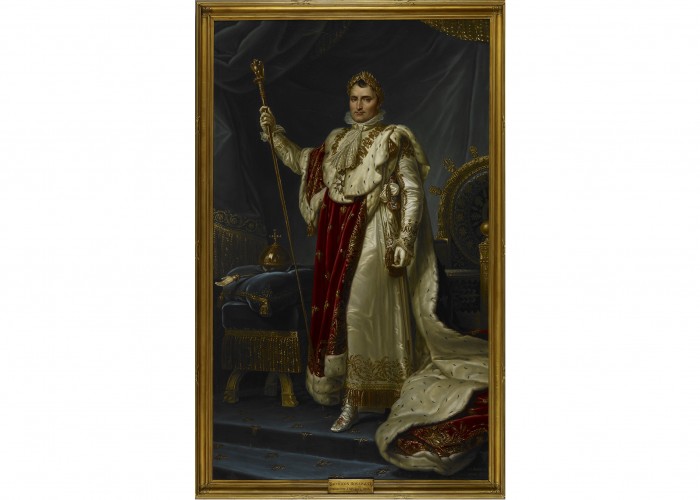Emperor Napoleon, Jean Baptiste Borély
This painting, completed in 1813, shows Napoleon in his robes as Emperor of the French. This image shows the pomp and grandeur that Napoleon adopted as Emperor, intended to reinforce his claim to the French Empire.
See a larger version of the painting here. This particular image was captured by Jean Baptiste Borély (1776-1823), who lived in Montpellier and specialised in landscapes and portraits. Bonaparte’s crimson velvet mantle was lined with ermine and embroidered with gold.
Napoleon, First Consul after he overthrew the Directory in October 1799, was elevated to Emperor by the Senate on 18 May 1804. Their act was confirmed in a referendum by the French people. His consecration took place in Notre Dame Cathedral in Paris on 2 December 1804. Napoleon clearly intended the occasion to evoke memories of Charlemagne, King of the Franks, who was crowned emperor of much of Western Europe at Aachen on Christmas Day 800.
Bonaparte’s crown, though newly-made, was deliberately medieval in style. His sceptre, meanwhile, was reputed to have belonged to another great European emperor, Charles V (1500-1558). Most obviously of all, Napoleon, in his new incarnation, revived memories of the Roman emperors.
The formalities concluded, France’s new emperor presented imperial standards to his assembled regiments. They surely found it more agreeable to swear loyalty to him, their idealised leader, than the impersonal idealism of the erstwhile Republic.
Napoleon’s intention in becoming Emperor may in part have been an attempt to commend himself to Roman Catholics. If so, it was rather spoilt by an ego which caused him to crown himself in front of what one can only imagine as a bemused Pope Pius VII. We can be more certain that he harboured dynastic ambitions. The following decade, of course, would dash those. He was defeated at the Battle of Waterloo in 1815 by the allied armies of Britain, Prussia and the Netherlands.
The people who guarded him in exile on St Helena after Waterloo were directed to call him general, not emperor. But a second empire did follow in the person of his nephew, Louis Napoleon (1852-1870). To maintain the fiction of a dynasty, he took the title Napoleon III in deference to Bonapartists who regarded Napoleon’s son, Napoleon Francois Charles Joseph Bonaparte (1811-1832) as Napoleon II. Napoleon had initially abdicated in his favour on 4 April 1814 but his coalition enemies insisted that he abdicate unconditionally.
-
Curatorial info
- Originating Museum: British Library
- Accession Number: G70043-04
- Creator: Jean Baptiste Borély
- Technique: Oil on canvas
-
Use this image
You can download a higher resolution image below, but please note the conditions of the licence.
- Rights Holder: Copyright British Library.
- License Type: All Rights Reserved
Find it here
This object is in the collection of British Library








